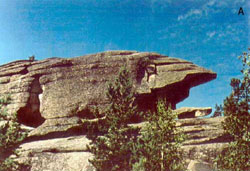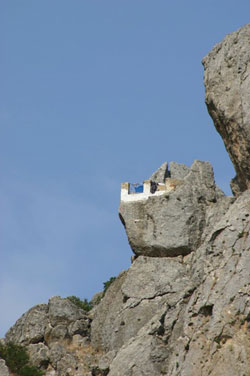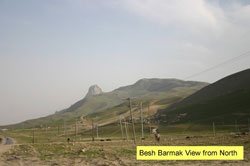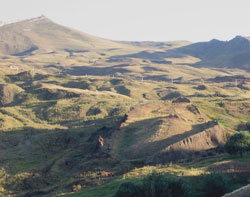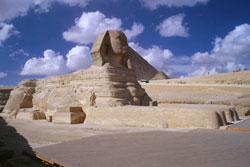Introduction
Azerbaijan is a land of mystery and intrigue. We need only consider the enigmatic and ancient Maiden Tower in the Old City, whose purpose and function remain conjectural, to realise just how little is known of its past cultures. While history is largely silent on its ancient past, archaeology informs us that its inhabitants were deeply spiritual, believed in life after death and in the supernatural. (Geyushev). Ancient beliefs involved the worship of natural phenomenon was essentially animistic, with the sun and moon playing important roles. Evidence of spirituality is seen in burial mounds or ‘kurgans’ where human remains in box-like tombs or ‘cists’ often face to the West – towards the setting sun, to the night time and the place of the dead. (Kvachidze,V., Pers comm.).
The reverence of anthropomorphic figures, symbolic of gods and goddesses was also common as can be seen in statues such as those on display at the Maiden Tower, or a male and female stele figures ceremonially buried in a kurgan. (Gallagher and Blair). The abundant rock art at Gobustan also provides insight into past environments, cultures and beliefs. However, what is not generally known is that there is a number of large anthropomorphic carvings in the countryside that have so far have gone unnoticed by academia. These carvings were not obvious to the author at first and only became apparent after many exploration trips into the countryside in search of Stone Age and Early Bronze Age sites.
The purpose of this paper is to raise awareness of the anthropomorphic image phenomenon and consider its potential significance: one that might help to shed light on some related mysteries.
Anthropomorphism
For anyone exploring the countryside, the large anthropomorphic images are not readily noticed. At best they might simply merit a passing comment or be of local interest. However, having found several examples in archaeologically rich areas, this went beyond coincidence and suggested a common animistic tradition. The images are essentially carved from natural outcrops to enhance various features and more closely resemble familiar objects, such as animals. This psychological aspect is human traits called ‘pareidolia’ whereby people generally try to rationalise their observations, a bit like noticing that the map of Italy looks like a boot, or seeing images in cloud formations. To ancient people such experiences were perhaps more real than they are in today’s scientific age. Typically the carvings are associated with burial mounds, stone circles, petroglyphs and rock shelters, so they not just imaginary.
The term given to the phenomenon by Russian scientists is ‘zoomorphism’ in relation to animals, of which Mount Ocharovatelnaia in the Altai Mountains is a good example. This rocky outcrop is carved to enhance its features so that it resembles a huge fish with a gaping mouth, (1). The megalithic tradition of the site is evident from the numerous ‘cup marks’ including some inside the mouth of the zoomorph. Studies conducted by the Hermitage Museum identified the site as an ancient sanctuary used for astronomic observation by prehistoric inhabitants. (Marsadolov), ( Bekbasser). Intriguingly from a nearby rock-art carved platform, the sun can be observed to set into the mouth of the ‘fish’ at the Spring Equinox – as if the creature is swallowing the sun, (2). This shows that the ancient Central Asiatic Nomads understood the movement of the heavens, and the sun’s daily and annual journeys across the sky. Indeed early Neolithic man was very experienced in astronomy and can best be seen at the astronomical observatory of ‘Carahunge’, a major stone circle site in Armenia. (Ruggles), (Wiki).
With ancient Turkic speaking people in Central Asia ‘worshipping’ at Mt. Ocharovatelnaia in an animistic and totemic manner, this suggests that anthropomorphic imagery in Azerbaijan may also be real and not just coincidental, thus suggesting the cultures are related. To these ancient people the countryside was alive with spirits and risks everywhere, e.g. in streams, in wood, mountains and the sky. Perhaps the images were therefore considered as spiritual or totemic guardians. Indeed, many animistic beliefs and superstitions continue today. Such a tradition goes back a long way into pre-history and is perhaps best seen in the Upper Palaeolithic site at Gobekli Tepe, – a ceremonial 11,000 year old temple complex in South Eastern Anatolian Turkey which was remarkably was built by hunter-gatherers only to be carefully buried. (Wiki).
It is against this background that we may consider the anthropomorphic rock formations in Azerbaijan and then discuss their possible significance. For convenience and in the absence of local names, ‘monikers’ are given to the carvings.
Turtle Rock
The first zoomorph discovered is located near Putta Mountain, – to the south of Baku. (Coordinates; N 400 18’ 54.7” E 490 37’ 51.7”). While it is possible that the features on this 3 metre tall head shaped rock may be natural, given that it is found close to a site of ancient human habitation, as evidenced by a nearby stone circle, rock art and burial mounds, this suggests the head and perhaps body were purposefully created by ancient man. At first, the rock was considered a curiosity perhaps carved for amusement by prehistoric people. With minimum modification, the rock may have had its mouth carved and an eye added in the right physiological location to give it the appearance of a turtle’s head. However, revisiting the site to look at it afresh, it became apparent that the head also had a body, and that the resemblance to a turtle (or tortoise) became more pronounced, (4). From whichever direction the head and small hillock are viewed the resemblance is apparent.
Whale Rock
Near the village of Rangebar, some 60 miles south of Baku, a much larger rock formation was found and termed ‘Whale Rock’ because of its size and appearance. (Coordinates – N 400 10’ 55.9”, E 490 6’ 58.1”). This 150m long figure is carved from a meter thick limestone layer which stands almost vertical, (5). While it is not possible to determine if the whole body has been modified to enhance the effect of a recumbent creature, it is evident that the head has been carved to give both an eye and a mouth; features unlikely to occur by chance.
The site shows many signs of settlement and includes a stone circle, rock shelters, burial mounds and a graveyard with several pre-Islamic tombstones, (8, 9). Throughout the ages, the site evidently provided shelter for animal herders or pastoralists as it does today, and perhaps was once a sheltered coastal settlement for hunting and fishing at a time when the Caspian Sea was much higher. The image shown looks to the East from behind the zoomorphs head, to the plain below which was once a shallow sea, (6, 7). As a distinctive landmark, ‘Whale Rock’ is likely to have had special significance to the ancients who lived there. Like other settlements it has all the necessities of life to hand – fresh water, limestone blocks as building material, good grazing in what would have been a wetter climate. With its sheltered south facing aspect, to protect from the prevailing cold northerly wind, perhaps to the ancient inhabitants, their overseeing zoomorph was their huge spiritual guardian.
Camel Rock
This figure resembles a seated camel and is located around 30 miles due west of Baku. (Coordinates – N 400 22’ 57.4”, E 490 15’ 47.4”). The single humped camel-like shaped is a 120 m long outcrop with a clearly defined head and an accurately positioned ‘eye’ that again appears to be a human modification, (10,11). Camel Rock is located in the middle of a plain and is visible for several miles: it can be seen from a distant hillside from an ancient stone circle. As with the Turtle and Whale sites, it shows signs of long term settlement and has a nearby fresh water stream and old burial mounds, (12). Curiously there are also several Persian style tombstones in its graveyard. (13). Evidently the site has been used from antiquity up into medieval times. Camel Rock is obviously archaeologically significant and may have been a stopping point on an old trade route, for it lies just north of an old dilapidated Caravanserai and to the south of an ancient vaulted water collecting cistern or ‘Ovdan’ site. This figure has clearly been used as a landmark throughout the ages. With its distinctive camel like appearance it was perhaps regarded in prehistory as evidence of a living landscape.
Owl Hill
Owl Hill is a considered a very important though unstudied megalithic site situated some 5 miles north of Camel Rock, (14). Its name was provided by local shepherds. It is very distinctive and with only a little imagination, it too can be regarded as a large animal. (Coordinates – N 400 27’ 39.6”, E 490 16’ 21.6”).
Apart from the shape of the hill, which drew attention in the first place, the typical pale brown discoloration of the settlement area, which is caused by organic enrichment from animal manure, makes the site visible from a distance. Below the hill a number of ancient features and cup-mark carvings can be found, some on several boulders delineating a perimeter. Most notable are nearby burial mounds (kurgans), a stone circle, several water collection systems, rock shelters and rock carvings, (15). Below the ‘head’ of the zoomorph there is also a superbly carved rock which has been hollowed out to form a narrow passageway, (17). The larger carvings are both mysterious and fascinating and no doubt once held cultural meaning. Owl Hill has clearly allowed communities to flourish over countless generations and like other zoomorphic rock formation sites was probably a significant settlement. With its rich archaeological remains much could be learned about Azerbaijan’s ancient inhabitants. Like many Neolithic archaeological sites found, Owl Hill should be protected and recognized by the Azeri government as an important heritage site.
Besh Barmak
‘Besh Barmak’ is one of the most fascinating and distinctive landmarks in Azerbaijan, (17). Today its name means ‘Five Finger’ mountain, but in older times was simply Mount Barmak or Xisr Xindi. With several hundred people visiting it daily, to climb up to its craggy top and offer prayers, it is an ancient site of pilgrimage steeped in legend and myth, with a large number of stone mounds that are thought to be ancient burial tombs, (18, 19). Barmak is clearly a significant and ancient spiritual location,
Most people see the mountain as a rocky crag with finger like digits, but from an anthropomorphic perspective, and a longer viewpoint ,a gigantic animal-like figure becomes apparent. (Coordinates 40°56’25.31"N 49°12’26.21"E). With only a little imagination the mountain can be seen to have an animal like head (the craggy peak) and a recumbent body. A nearby dominant raised terrace is also evident and indicates a previous Caspian Sea high stand level, thus indicating Besh Barmak was once surrounded on its seaward side by water.
Besh Barmak Tail or Serpent.
Considering that the mountain might be a zoomorph, it was examined further using ‘Google Earth’. Intriguingly a long winding track, correctly positioned at the rear of the mountain, as if to represent a huge tail, was found, (20). (Coordinates 40°56’26.23"N 49°12’30.68"E). On inspection it became obvious that the ‘tail’ was a man made, seemingly going uphill for no apparent reason. It was an odd find with its one thousand meter long zig-zag winding path up to two decorative lozenge shapes at the top. There are also no signs rutting to suggest it was used as a roadway or by horses. Local shepherds were unaware of who constructed it, so making it older than the Soviet era. Discounting ideas that it might be a roadway, a quarry access or had any military function, it seems reasonable to assume that it could be an anthropomorphic or decorative feature. Its purpose and age yet need to be determined.
In keeping with a tradition of landscape carvings, it is not unreasonable to suggest it had some sort of cultural function. It is also possible that the track-like carving is not a ‘tail’ but may represent a snake or serpent. This is a possible conjecture for serpents have played a major role in many ancient myths and legends. Perhaps to ancient people it had two symbolic meanings: both as a tail and a serpent. If the latter is agreed then this would make the ‘serpent’ carving the largest known in the world. It’s worth noting here that in America, prehistoric Indians, or Paleo-Indian carved the ‘Serpent Mound’ in Ohio which at some 410m long is considered the longest snake-like carving in the world. (Wiki). Another 130 m long man made serpentine zoomorph may be found at Loch Nell, near Oban in Scotland. Serpent worship (i.e. Ophiolatrea) was a significant ancient belief in ancient times.
Human Image
The ‘serpent’ cannot be viewed from the track below. To see it properly it is necessary to climb the opposite hillside and view it from above, but in doing this another possible carving was found that overlooks both the ‘snake’ carving and Besh Barmak. In full view, but unnoticed, some four kilometres distant a huge human-like image seems to be carved into the hillside close to the skyline, (21). (Coordinates; 40°54’13.45"N 49°11’58.48"E).
Unlike other exposed rock faces in the area that show natural erosion features, the human figure (called ‘Enoch’ on account of prophet the legend associated with Besh Barmak), has a number of unusual angular features which suggest it is not a natural outcrop. It is as if the steeply angled hillside was deliberately scraped clean to reveal the underlying rock and delineate the image of a person with upraised arms. Such a gesture is not uncommon in Azerbaijan rock art imagery and is often associated with other ancient carvings and pottery. If it is a genuine carving then it should be possible to establish the age of the sculptures by radiocarbon dating organic remains below the excavation debris. Interestingly in contrast to the angular Enoch, a nearby semi circular rock exposure may also be associated with the human like carving.
‘Enoch’ is 200 m across its outstretched hands and around some 200 m in height. Once noted, it can easily been seen from many kilometres away including the top of Besh Barmak, the coastal highway and Caspian Sea. In a manner not unlike the early Bronze Age English hillside carvings, such as the Cerne Abbas Giant and White Horse of Uffington, the image could well be of ancient cultural significance and importance. (Wiki). What is certain is that image overlooks a remarkable landscape. In addition to overlooking Besh Barmak and the ‘serpent/tail’, it also oversees a few old deserted villages, several intact large burial mounds (kurgans), a stone circle and other ancient remains, (22).
Besh Barmak is evidently of immense archaeological significance and may well have been known about in history. Indeed research indicates it might be recorded by the 6th Century Byzantine geographer and Egyptian monk Cosmas Indicoplustes. (Wiki) Cosmas gives information on a small mountain to his north that is considered to be solar observatory. His description is similar in several ways to Besh Barmak, i.e. it is animal like with a body and a head, the mountain sits in water, it faces the east, it has three distinctive lines (strandlines) across it and from research may well be is associated with solar observation, (22, 23, 24)
Discussion and Summary.
In this abstract, links have been made between prehistoric peoples and natural rock outcrops which may have thought of as anthropomorphic images. Examples described include Turtle rock, Whale Rock, Camel Rock, and Owl Hill and possibly Besh Barmak with its two associated anthropomorphic images – the Besh Barmak Serpent and Enoch. If investigated and confirmed, anthropomorphism could become recognized as an important cultural tradition in Azerbaijan’s ancient past, and elsewhere: one that continued into the middle ages. With supporting observations from Kazakhstan’s Mt Ocharovatelnaia it is evident that zoomorphism is a subject that has been insufficiently studied in archaeology and anthropology. The examples highlighted above ought to be investigated, recognized as being culturally important and sites protected. Indeed, by acknowledging the phenomenon it is possible that this might begin to offer an insight into some perplexing mysteries.
An example of a probable anthropomorphic image is that of Noah’s Ark site in Eastern Turkey at Durupinar. This natural boat shaped rock formation has confounded scientists for decades, as it is obviously natural but has carved features that give it the appearance of a boat, e.g. wooden beams, (27). The site has long been known about and revered, – possibly even recorded by Berossus, a third century BC Babylonian priest in his account of a great flood and Xisuthrus’s ark like vessel. (Berosus). The story of Xisuthrus and Noah appear to have common origins. Intriguingly he reports that pilgrims visiting the ark site in antiquity would return with samples of bitumen in order to prepare amulets. With no local sources of bitumen this is most odd. However, in the context of anthropomorphism it makes sense to consider that the rock outcrop was identified in prehistory as a large boat and then physically modified, and decorated, to better resemble a huge vessel. This would account for the carving and addition of bitumen. It further makes sense when the ancient belief that rain came from an invisible ocean in the sky is considered. Indeed the Egyptians believed that the Barque of Ra carried the sun daily across the heavens. It may then be postulated that in the light of an anthropomorphic tradition and against a background of ice age flooding, myth and legend to think that the Durupinar site was established as a sacred location in commemoration of Noah and mankind’s salvation from the great flood.
Another equally mysterious example in Azerbaijan is the Fairy Castle (or locally Peri Gala). (Gallagher). (Coordinates: 41°35’23.21"N 46°45’53.78"E). Close up it looks to be a most odd structure carved into a cliff face, (25). But from a distance the castle can be seen to be a huge eye-like construction, (much as a sculptor would create in a statue). The ‘eye’ is set into a rock face to give the illusion of a huge head facing westwards, (26). Having, puzzled for several years over the Fairy Castle, it is only now and through the lens of anthropomorphism that the site make any sense. Its notable that the monument is located in an archaeologically rich area with several ruined churches and buildings, some megaliths and ancient graveyards. Its now suspected as being a temple or observatory of sorts to view the summer solstice sunset over the peak of the nearby Baxuvul mountain. Curiously radiocarbon dating shows it to be almost 1000 years old so making it contemporary with the reconstructed Maiden Tower in Baku, which has an opposite focus to the winter solstice sunrise. Both monuments may therefore be linked through a sun veneration culture.
Lastly, perhaps in recognizing the deep rooted anthropomorphic tradition, I might also help to resolve one of the world’s greatest mysteries. Taking into consideration other strands of research that suggest connections to ancient Egypt, it should be noted that the Father of Archaeology, Sir William Mathews Flinders Petrie held the controversial view that the earliest Egyptians had an ancestral homeland in the Caucasus. (Petrie). (Murray). His evidence was largely based on philology with some archaeological, but at the time his views were discounted as not being credible. However, if archaeology begins to recognizes anthropomorphism as an important tradition, then its reality may provide a tangible link to ancient Egypt and an explanation for the world’s most famous anthropomorphic image, – the mysterious Sphinx on the Giza plateau, (27).
Some scientists consider the Sphinx to be much older than the pyramids, dating back some ten thousand years or so. If so, then, taking into account evidence of massive ice age flooding across the Ponto Caspian and likely migrations from the region as waterways disappeared and lifestyles affected in the Early Neolithic, it seems possible that people, customs and traditions travelled with them to the Nile Valley, thus supporting Flinders Petrie’s contention of a Caucasian ancestral homeland. In this regard, perhaps the most important cultural and anthropomorphic image – Besh Barmak, was commemorated in the carving of the Sphinx. Curiously the Sphinx, whose ancient name was Hor-em-akhet to the Egyptians and which the ancient Greeks later called Harmakhis, bears a close philological resemblance to the word ‘Barmak’. For millennia the Sphinx has remained enigmatic and mysterious. Perhaps then with a focus on anthropomorphism and investigation in that solid archaeological evidence of cultural connections might be discovered. Evidence of animism and sun worship in Azerbaijan and the Caucasus would seem to support ancestral links to predynastic Egypt. Perhaps Flinders Petrie may be proved correct after all, and it is hoped that his challenge to future archaeologists to investigate connections might be accepted.
In summary, there appears to be sufficient anthropomorphic examples associated with ancient settlement sites in Azerbaijan to warrant serious consideration and investigation. Others no doubt exist and need to be identified, recorded and studied. Perhaps with open minded investigation into this animistic phenomenon and an acknowledgement of its reality and potential importance, it may be possible to roll back the pages of history to a distant and more formative time to better understand mankind’s cultural origins.
Photographic Section
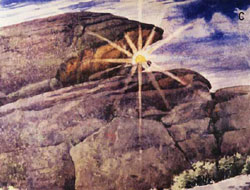
2. Artistic representation of Mt. Ocharovatelnaia at the Spring Equinox seen devouring the setting sun.
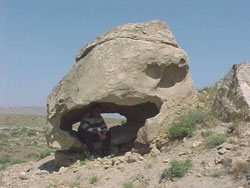
3. Turtle Rock Head with a friend sitting in ‘mouth’ to show scale. Its features suggest an outcrop was enhanced by carving.

4. Turtle Rock. A carved stone thought to represent the head of a turtle shaped zoomorph. Located near to an ancient settlement with rock carvings and a stone circle. Cup mark located on highest boulder.

13. One of several Persian headstones in an ancient graveyard at Camel Rock indicating ongoing use from more ancient times.

15. Stepping stones leading up to a water collecting cistern below Owl Hill: one of three nearby water collecting cisterns.

16. Multiple carved rock at Owl Hill with a narrow passageway. Many megalithic sides have stones with opening in them to provide a crawl space.

17. Southerly view of Besh Barmak showing an adjacent raised beach, indicating that at a Caspian high stand the mountain would be surrounded by water.

20. Serpentine like 1000m long track at rear of Besh Barmak. The excavation seems to serve no obvious purpose and may be ceremonial. Suggestions for it are an anthropomorphic tail or a snake with either two heads or open jaws

21. Human image (Enoch) with upraised arms overlooking Besh Barmak. The image is 200m across and can be seen from afar. Note circular carving to right.

22. Artist impression of extant drawing by Cosmas Indicopleustes. Animal like crooked mountain showing the sun in east and west. Note three prominent lines which the monk thought were to do with seasons.
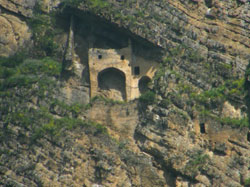
25. Close up view of the Fairy Castle (Peri Gala). Central plinth in centre of archway and wall to left may have been deliberately destroyed by past conquerors.
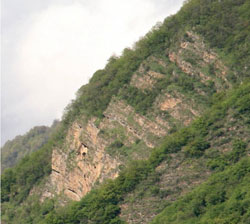
26. Long view of the Fairy Castle seen as a huge head complete with a tall hat. The eye nose and mouth carved in correct proportions.
Discuss this article on the official thread on the GrahamHancock.com messageboards
References
- Berosus (via Alexander Polyhistor) (50BC). Flood History of Babylonia. Ref:
- http://www.noahs-ark.tv/noahs-ark-flood-creation-stories-myths-berossus-xisuthrus-babyloniaca-history-of-babylonia-abydenus-apollodorus-alexander-polyhistor-josephus-eusebius-georgius-syncellus-oannes-280bc.htm
- Bekbasser, N., (2005) ‘ Astronomical Practices and Ritual Calendar of Euro-Asian Nomads. http://www.folklore.ee/folklore/vol31/bekbassar.pdf
- Gallagher, R, Blair, B. (2006) Secrets of the Maiden Tower: What they Reveal about Early Man’s Beliefs’. Azerbaijan International. Vol 14.3 http://azer.com/aiweb/categories/magazine/ai143_folder/143_articles/143_mt_secrets.html
- Gallagher, R. (2005) ‘Parigala, Mystery Surrounds “Fairy Castle” ‘Azerbaijan International, pp 74-77. Vol 13.3 http://www.azer.com/aiweb/categories/magazine/ai133_folder/133_articles/133_gallagher.html
- Geyushev, R. (1999). ‘The Archaeology of Azerbaijan, – A Brief Discourse.’ (1999).
- Marsadolov, L., (2005) ‘Mt Ocharovatelnaia and Mt Siniaia in Altai: Legends and Reality. http://www.folklore.ee/folklore/vol31/marsadolov.pdf
- Petrie, Sir William Flinders. (1926) ‘The Origins of the Book of the Dead.’ (Ancient Egypt, June).
- Murray, M. ‘Connexions between Egypt and Russia’. Antiquity. Vol. 15:60 pp 384 – 385.
- Murray, M. (1949). The Splendour That Was Egypt. Sidgwick & Jackson Ltd ed (1964)
- Ruggles, C. (2005). Ancient Astronomy pp65-67.
- Wikipedia: Carahunge. http://en.wikipedia.org/wiki/Carahunge
- Wikipedia: Cerne Abbas Giant. http://en.wikipedia.org/wiki/Cerne_Abbas_giant.
- Wikipedia: Cosmas Indicopleustes. http://en.wikipedia.org/wiki/Cosmas_Indicopleustes.
- Wikipedia: Gobekli Tepe. http://en.wikipedia.org/wiki/G%c3%b6bekli_Tepe
- Wikipedia: Serpent Mound. http://en.wikipedia.org/wiki/Serpent_Mound
- Wikipedia: Uffington White Horse. http://en.wikipedia.org/wiki/Uffington_White_Horse.





